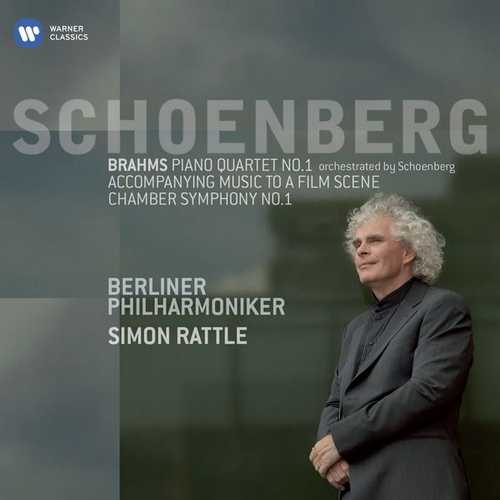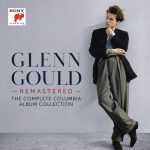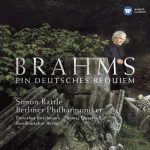

Composer: Johannes Brahms, Arnold Schoenberg
Orchestra: Berliner Philharmoniker
Conductor: Sir Simon Rattle
Format: FLAC (tracks)
Label: Warner
Catalogue: 4578152
Release: 2011
Size: 681 MB
Recovery: +3%
Scan: yes
Brahms: Piano Quartet No. 1 in G minor, Op. 25 (arranged for Orchestra)
01. I. Allegro
02. II. Intermezzo – Allegro ma non troppo
03. III. Andante con moto
04. IV. Rondo alla Zingarese
05. Schoenberg: Accompaniment to a Cinematographic Scene, Op. 34
Schoenberg: Chamber Symphony No. 1 in E major, Op. 9
06. I. Lento – Allegro molto
07. II. Con fuoco – Tempo primo – Poco meno mosso – Presto
08. III. Lento – Molto lento – Più moto – Tempo primo
09. IV. Tempo primo – Animato poco a poco – Tempo primo – Molto vivace
Following the release of the complete Brahms symphonies (“Altogether a marvellous achievement.” The Daily Telegraph), Sir Simon Rattle and the Berliner Philharmoniker have performed and recorded a programme of orchestral works by Arnold Schoenberg, who was a great admirer of Brahms.
In these three contrasting works, the spirits of Modernism, Romanticism and Classicism are invoked by Arnold Schoenberg – a revolutionary whose aesthetic roots lay firmly in tradition. Sir Simon Rattle, who first established his international reputation with masterpieces of the 20th century, explores these musical cross-currents with the Berliner Philharmoniker, long supreme in Austro-German repertoire.
The repertoire, recorded in concert at Berlin’s Philharmonie in late October/early November 2009, consists of Schoenberg’s orchestration of Brahms’s Piano Quartet in G minor, Begleitungsmusik zu einer Lichtspielszene (Accompanying Music to a Film) and the full orchestra version of the Chamber Symphony No. 1.
In these three contrasting works, the spirits of Modernism, Romanticism and Classicism are invoked by Arnold Schoenberg – a revolutionary whose aesthetic roots lay firmly in tradition. Sir Simon Rattle, who first established his international reputation with masterpieces of the 20th century, explores these musical cross-currents with the Berliner Philharmoniker, long supreme in Austro-German repertoire.
Immediately after the recent performances/recordings, Sir Simon and the Orchestra set off on a coast-to-coast U.S. tour performing the Brahms symphonies and this Schoenberg programme at New York’s Carnegie Hall and in San Francisco, Los Angeles, Boston, Chicago and Ann Arbor.
Schoenberg said that he had arranged Brahms’s Piano Quartet in G minor, Op. 25 for orchestra in 1937 for several reasons: “1) I like this piece; 2) It is seldom played; 3) It is always played badly, because the better the pianist, the louder he plays and you hear nothing from the strings. I wanted once to hear everything, and this I achieved.” He also stated that he intended to write his orchestration strictly in the style of Brahms, going no further than Brahms would have gone “if he had lived today.”
Mark Swed, in The Los Angeles Times, said of the LA performance, “When [Schoenberg] made the version in 1937, he had recently moved from Berlin to Los Angeles and was clearly entranced by the resplendent light of his new home. He garbs the quartet in garish instrumental colors … Rattle emphasized everything in the most polystylistic way possible. A horn solo in the solo movement had a raw jazzy quality; a clarinet solo in the Gypsy-inspired last movement was klezmer-like. A xylophone clattered, a bass drum thumped. But within this ruckus was also ravishing ensemble playing and, from Rattle, the inspiration not only for great characterization but also for momentum.”
Allan Kozinn in The NY Times wrote of the Carnegie Hall performance, “It can be hard to banish the original sound and texture from your inner ear, however convincing the new interpretation may sound. But it can be worth the effort, as Mr. Rattle and his musicians demonstrated in a vital, shapely account that found levels of drama in Schoenberg’s magnification that a performance of the chamber version could not possibly equal.” Simon Rattle previously recorded this work with the City of Birmingham Symphony Orchestra in 1985.



